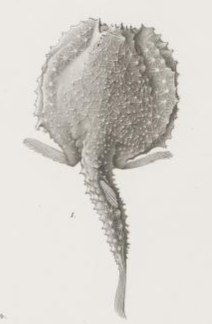
Halieutopsis is a genus of marine ray-finned fishes beloning to the family Ogcocephalidae, the deep sea batfishes. The species in this genus are found in the Indian and Pacific Oceans.

Dibranchus is a genus of marine ray-finned fishes belonging to the family Ogcocephalidae, the deep sea batfishes. The fishes in this genus are widely distributed in the Atlantic, Indian and Pacific Oceans.
Solocisquama is a genus of marine ray-finned fishes belonging to the family Ogcocephalidae, the deep sea batfishes. The species in this genus are benthic fishes found in deep waters in the Indian and Pacific Oceans.
Halieutichthys bispinosus, the two-spine batfish or spiny batfish, is a species of marine ray-finned fish belonging to the family Ogcocephalidae, the deep sea batfishes or seabats. This species is found in the Western Atlantic Ocean.

Halieutopsis andriashevi, Andriashev's deepsea batfish, is a species of ray-finned fish belonging to the family Ogcocephalidae, the deep sea batfishes. This fish is found in the western Indian Ocean.

Halieutopsis galatea, the Galathea deepsea batfish, is a species of ray-finned fish belonging to the family Ogcocephalidae, the deep sea batfishes. This fish is found in the Indian Ocean.
Halieutopsis ingerorum, Ingers' deepsea batfish, is a species of ray-finned fish belonging to the family Ogcocephalidae, the deep sea batfishes. This fish is found in the Western Indian Ocean.
Halieutopsis echinoderma, the spiny deepsea batfish, is a species of ray-finned fish belonging to the family Ogcocephalidae, the deep sea batfishes. This fish is found in the Western Pacific Ocean.
Halieutopsis kawaii, Kawai's deepsea batfish, is a species of ray-finned fish belonging to the family Ogcocephalidae, the deep sea batfishes. This fish is found in the Western Pacific Ocean.
Halieutopsis taiwanea, the Taiwan deepsea batfish, is a species of marine ray-finned fish belonging to the family Ogcocephalidae, the deep sea batfishes. This species is found in the northwestern Pacific Ocean off Taiwan.
Halieutopsis murrayi, Murray's deepsea batfish, is a species of ray-finned fish belonging to the family Ogcocephalidae, the deep sea batfishes. This fish is found in the Western Indian Ocean and was first described to science in 2021 from a holotype collected in the 20th century.
Halieutopsis okamurai, Okamura's deepsea batfish, is a little known species of marine ray-finned fish belonging to the family Ogcocephalidae, the deep sea batfishes. This species is found in the northwestern Pacific Ocean, and is known only from a single specimen collected between the Ogasawara Islands and Izu islands in 1968.
Halieutopsis margaretae, Margaret's deepsea batfish, is a species of ray-finned fish belonging to the family Ogcocephalidae, the deep sea batfishes. This fish is found in the Western Pacific Ocean.
Halieutopsis oblonga, the oblong deep-sea batfish, is a species of marine ray-finned fish belonging to the family Ogcocephalidae, the deep sea batfishes. This species is found in the Western Pacific Ocean.

Halieutopsis stellifera, the starry deepsea batfish, is a species of marine ray-finned fish belonging to the family Ogcocephalidae, the deep sea batfishes. This species is found in the Indo-West Pacific region.

Halieutopsis simula, the fluffy-esca deepsea batfish, is a species of marine ray-finned fish belonging to the family Ogcocephalidae, the deep sea batfishes. This species is found in the Indo-West Pacific region.

Halieutopsis tumifrons,the truncate-snout deepsea batfish, is a species of marine ray-finned fish belonging to the family Ogcocephalidae, the deep-sea batfishes. This species is the type species of the genus Halieutopsis. It is a little known species only known from the two type specimens collected off the Galápagos Islands in 1890.

Halieutopsis nasuta, the big-nosed deepsea batfish, is a species of ray-finned fish belonging to the family Ogcocephalidae, the deep sea batfishes. This fish is found in the Indian and Pacific Oceans. H. nasuta is classified within the genus Dibranchus by some authorities, but is generally considered to belong in the genus Halieutopsis.
Halieutopsis nudiventer, the naked-belly deepsea batfish, is a species of ray-finned fish belonging to the family Ogcocephalidae, the deep sea batfishes. It was originally found in the eastern Indian Ocean around the Bay of Bengal, but is now known to have a wider distribution in the Indo-Pacific.

The Caribbean batfish, also known as the two-spine batfish, is a species of marine ray-finned fish belonging to the family Ogcocephalidae, the deep sea batfishes or seabats. This species is found in the Western Atlantic Ocean.










